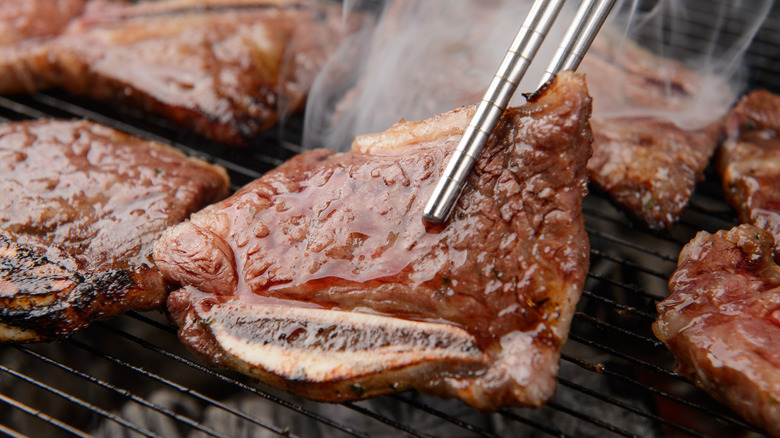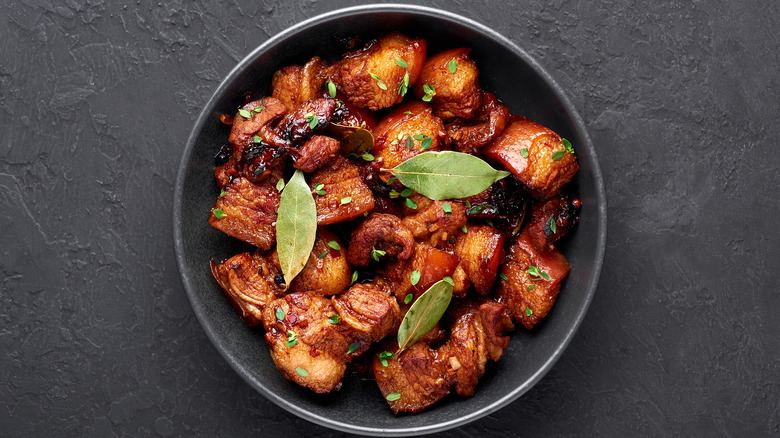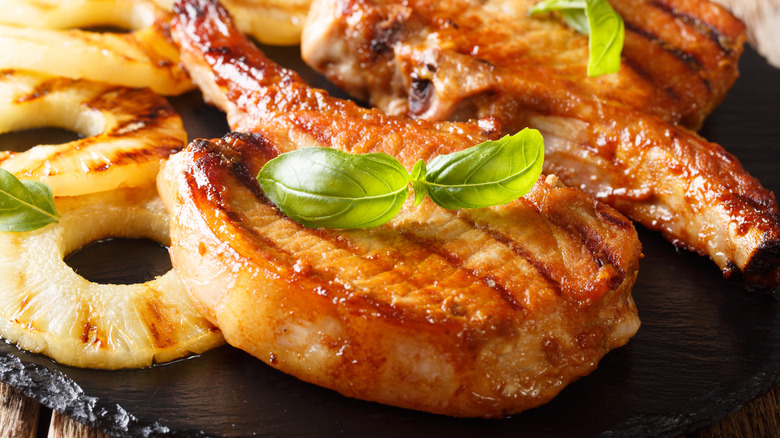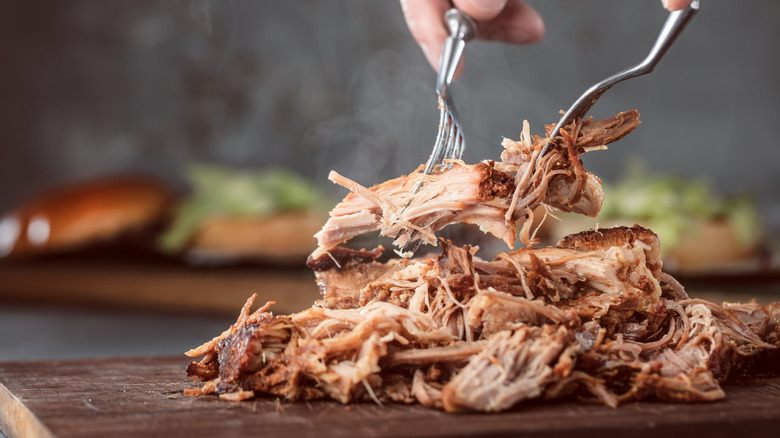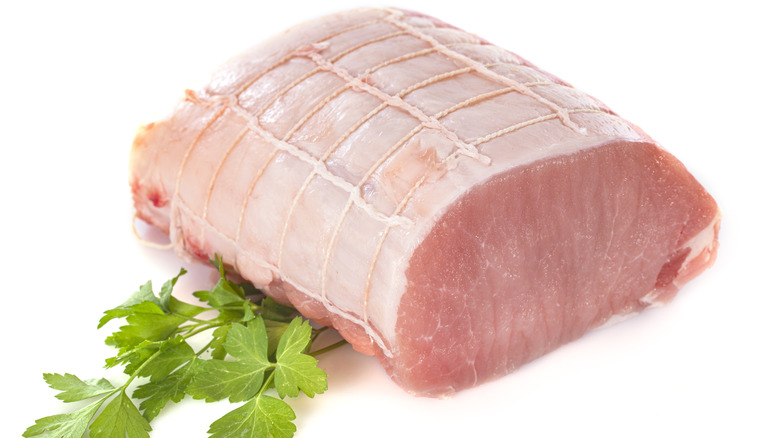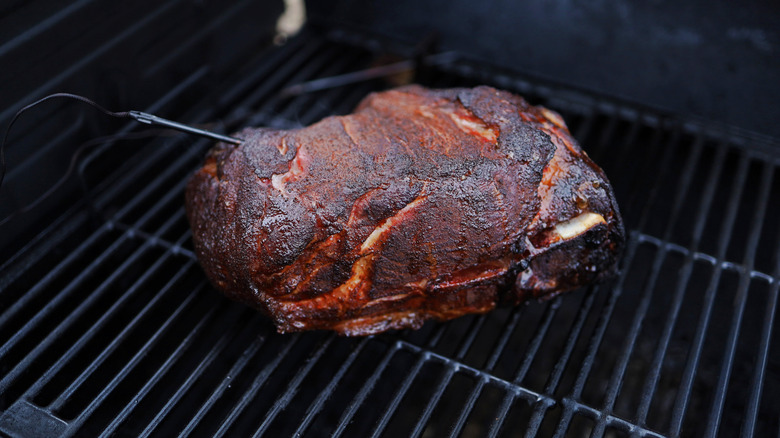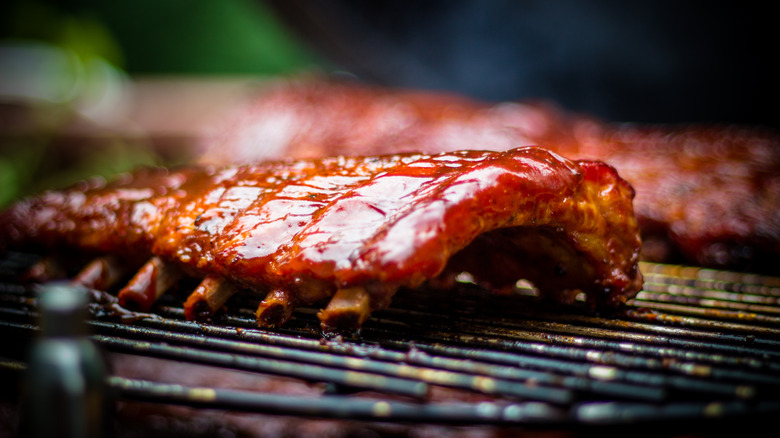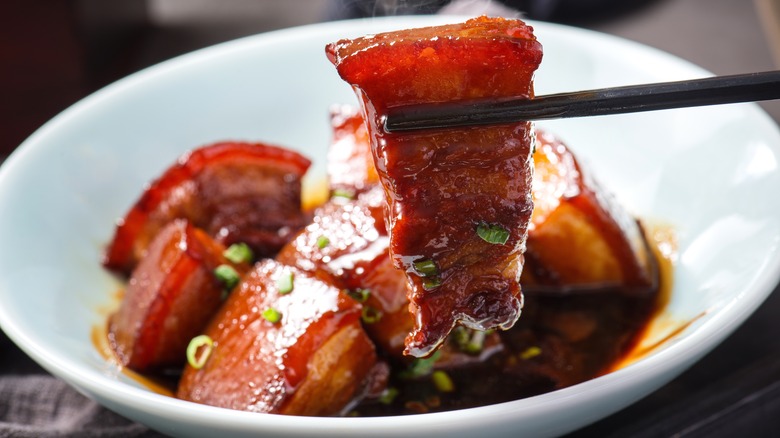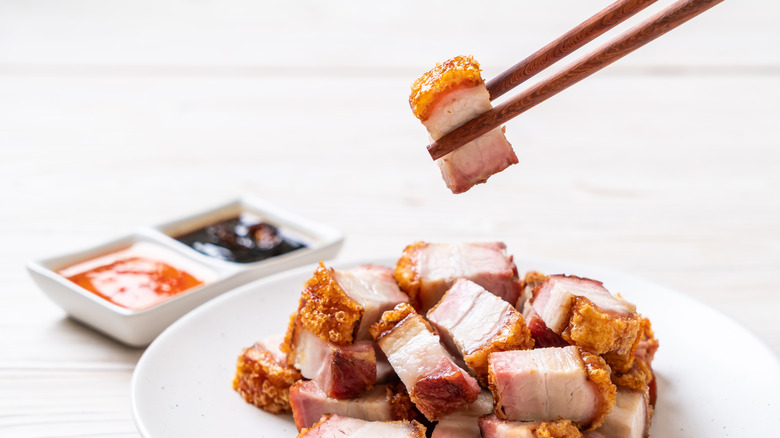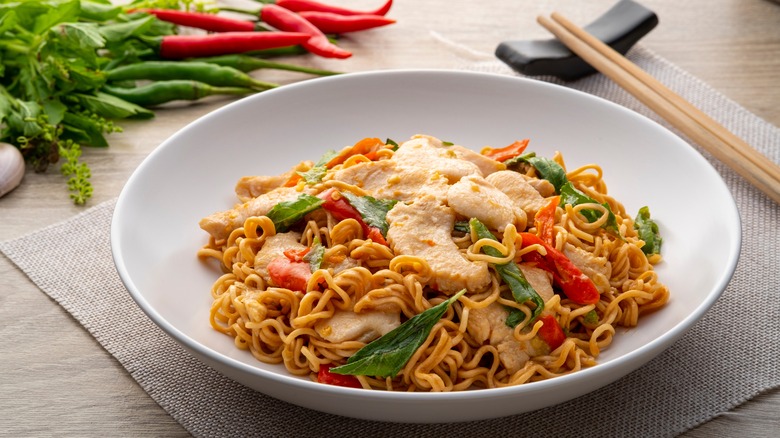11 Tips You Need When Cooking With Pork
The late, great Anthony Bourdain famously loved pork, once referring to it as his favorite vegetable. While your love of all things porcine may not be as strong as Bourdain's, you should still be cooking the other white meat with proper technique and good ingredients.
One big reason to bone up on your pork knowledge is the number of options that are available to you. There are many different cuts of pork that weren't in the supermarket just a few years ago, with pork belly probably being the best example. No longer just used to make bacon, pork belly was first a trendy chef ingredient, and now it's a cut that you can find almost anywhere. Pork belly is also a cut that requires a bit of work. You can't just toss it in a hot cast-iron pan for 10 minutes. It requires low and slow cooking, as well as a special technique if you want crispy skin. Read on to find out about that technique and learn more tips for cooking pork.
Know the differences between similar cuts
Pork loin and tenderloin. Spare ribs and baby back ribs. Pork butt and pork shoulder. Many cuts of pork have similar names or appearances. Some of the most important things to know when you're cooking with pork are the differences between similar-sounding or -looking cuts.
The difference between pork loin and pork tenderloin is probably the hardest one to figure out. Both cuts are fairly lean and come from the same part of the pig. But that's where the similarities mostly end. Pork loin is a much bigger cut, typically weighing four or five pounds, while tenderloin typically weighs about one pound. Pork loin also has more fat and it tends to require a longer cooking time.
The difference between spare ribs and baby back ribs can also be difficult to suss out. The biggest differences are size and meatiness. Baby back ribs tend to be shorter and meatier, while spare ribs are longer, flatter, and less meaty. However, spare ribs tend to be fattier, making them more flavorful.
The shoulder of a pig is cut into two different parts: pork butt and pork shoulder (which is sometimes called "picnic shoulder"). Pork butt comprises the upper part of the shoulder located behind the shoulder blades. Because this part of the shoulder does less work than the lower part of the shoulder, pork butt is much fattier, and as a result, more flavorful.
Use apple cider in a pork braise
Imagine a whole roasted pig or a pig's head on a buffet and you'll probably picture an apple stuffed into its mouth. Although was don't serve pigs this way as much as we used to, pork and apples are a classic pairing that never gets old. It can be traced back to a time when savory dishes like pork were often served with sweet sides made from fruit.
Fortunately, you don't have to roast an entire animal to enjoy this delicious combination. Our pan-seared pork chops with parsnip-apple puree recipe is an elegant way to combine apples and pork. It takes pork chops and applesauce to the next level by incorporating spice into the puree and basting the chops in rosemary-infused brown butter. You could also use apple cider to braise pork or employ apple cider vinegar in our easy pulled pork recipe. Likewise, a splash of apple cider can work wonders when reheating pulled pork.
Pair pork chops with more than just apples
Although apples are a classic pairing with pork chops, they are a very versatile cut of meat that pairs well with other fruits like peaches and pineapples. Pairing peaches with pork chops is a particularly good idea in summer when the fruit is in season. If you're looking for a sweet-savory spin on pork chops and peaches, toss peach slices in a pan on medium heat for 4 or 5 minutes, and then create a sauce by adding white wine and a knob of butter. If you're more into a kick, spicy peach salsa can cut through the richness of pork chops with acid and heat.
Ham and pineapple on pizza gets a bad rap, but the combination of pork and pineapple is a solid one. In many Asian cuisines, pineapple is used to create a sweet and sour sauce that goes with all kinds of pork dishes. If you're looking to try this pan-Asian combination, check out our pineapple pork loin recipe.
Use pork shoulder cuts for pulled pork
When Homer Simpson referred to the pig as a magical animal, he was probably thinking about pulled pork, one of the most versatile and forgiving kinds of meat. Whether you're smoking, slow braising, or pressure cooking, it's almost impossible to overcook pulled pork. It can be used in all kinds of dishes from nachos to bao buns, and it doesn't get rubbery when you try to reheat it. However, you can't get good pulled pork from just any cut of pork.
The best cuts of meat for pulled pork are shoulder cuts, which include the aforementioned picnic shoulder and pork butt. These cuts have a lot of fatty and connective tissue that can be broken down by low-and-slow or pressure cooking. While both cuts are great, pork butt — or Boston butt — is the better of the two cuts because it typically has more fat. These cuts are typically sold as large chunks of meat weighing multiple pounds. For the sake of convenience, you can easily use a single pork butt to make a big batch of pulled pork with basic seasoning and then use the meat in many different dishes, adding seasoning accordingly.
Pork loin will take on all kinds of seasonings
Pork loin has a very subtle pork flavor and because of that, it's able to take on all kinds of seasonings and flavor profiles. When seasoning pork loin, you can go two different routes: a marinade or a dry rub. Because a marinade contains an acid like vinegar, it can help to tenderize the pork loin as it imparts flavor. If you cut your pork loin into thin slices, a 12- or 24-hour marinade can be enough to tenderize the meat to use faster cooking methods. A dry rub, on the other hand, only imparts flavor, making it more important to use a low-and-slow cooking process.
If you want a perfect marinade for pork, you should use one based on apple cider vinegar. We like a pork marinade that also includes mustard, time, olive oil, lemon juice, salt, and pepper. But you are also free to come up with your own. Just make sure it contains an acid, some type of fat, and whatever seasonings you like.
The two key ingredients in a dry rub are salt and sugar. Other seasonings can be added based on personal preference. Our three-ingredient dry rub recipe couldn't be easier. Simply mixed together garlic salt, brown sugar, and hot smoked paprika.
Know the correct cooking temperature
If you hated pork as a kid because it was always dried out and tough to eat, you should know that people were probably overcooking pork for many years. The current recommended internal temperature is 145 degrees Fahrenheit, but for many years, the recommended temperature had been much higher: 160 degrees Fahrenheit.
Experts had been recommending the higher temperature out of an abundance of caution. Raw pork can harbor bacteria that cause trichinosis, a debilitating disease. In the 1920s and 30s, trichinosis was prevalent, but improved conditions in the meat industry have significantly lowered the risk of contracting the disease. The USDA tacitly acknowledged this lower risk when it updated its recommendations to include the lower temperature.
In fact, 145 degrees F is the ideal temperature for perfectly cooked pork. A University of Illinois study found participants consistently preferred pork cooked to this temperature compared to pork cooked at 160 degrees F. So the next time you cook pork, insert your meat thermometer into the center of the cut and remove it from the heat if you see a temperature of 145 degrees F or higher.
Avoid excessive trimming before smoking pork
Before smoking a cut of pork, you might be tempted to trim away extra fat or connective tissue, but smoking is a low-and-slow cooking process that does magical things with these tissues. The last thing you want to do is trim them away.
So, what are the best cuts of pork that you should be smoking? Pork shoulder is a very cheap cut and smoking it doesn't take much effort. You may be tempted to cut away any pork skin, but hours in a smoker will turn it into a crackling, savory treat. Pork collar is another great cut for smoking, and you should absolutely leave on the outer layer of attached fat because it adds flavor. Ham hocks are more associated with stews and braises, but they are a great cut for the smoker. In fact, ham hocks are used to make the iconic Oktoberfest dish schweinshaxen.
Trotters are the one cut of pork that requires a bit of trimming, of a sort. Pigs' feet often come with a bit of hair on the toes that you should probably remove with a disposable razor. Unless you like the taste and texture of smoked hair, that is.
Add sauce to barbecue ribs at the perfect time
Barbecue sauce is so delicious you may have the urge to slather as much as possible on your ribs, starting as early as possible. However, you shouldn't sauce your ribs too early, especially if you're using a sugary sauce. If you do, you'll char the sauce and pass on burnt flavors to your ribs. umm
The best time to add sauce to ribs depends on the heat you're using to cook them. If you are cooking them low and slow, at about 225 degrees F, you can apply sauce as early as 30 minutes before the end of your cook time. If you are using a higher temperature that isn't blazing hot, you should wait until about 10 to 15 minutes before your ribs are done.
You could apply barbecue sauce earlier than that, but you should first water it down to dilute the amount of sugar that could potentially get burned. Once your ribs are done cooking, you can go ahead and apply a coating of undiluted sauce.
Slow cook for tender pork belly
Skinless pork belly contains two layers: a layer of fat and a layer of tough muscle. One of the biggest mistakes you might be making with pork belly is cooking it at high heat. To achieve tender, melt-in-your-mouth pork belly, you need to cook it low and slow. Smoking, braising, or roasting at low heat melts collagen in the muscle layer, tenderizing it. Because the muscle layer is so tough, the cooking process can take around 4 hours, possibly more. If you are smoking or roasting, you'll have to baste the belly as it cooks to prevent it from drying out. If you've done it right, your cooked pork belly should be easily pierced with a fork. Let your pork belly rest for 10 to 15 minutes before serving it.
While properly cooking a pork belly with basic seasoning is a great thing, this cut is incredibly versatile and you can dress it up in many different ways. Taste the Pacific islands with a Kalua pork belly recipe, which involves marinating the belly in a blend of soy, mirin, chicken stock, and aromatics. Or enjoy the Thai culinary staple moo palo, which is pork belly braised in a spicy stew and served with boiled eggs.
Season skin with salt to crisp it up
The truth about pork rinds is that there are actually made from crispy pig skin. But did you know you can easily make crispy pig skin right in your kitchen? Pork shoulder and pork belly are popular cuts that often come with the skin attached. To crisp up that skin, take a page out of Gordon Ramsay's pork belly recipe: Use a sharp knife to score it diagonally at half-inch intervals and then heavily rub the skin with salt and pepper. After you've scored and seasoned your skin, you can smoke it or roast it at a low temperature to get that crispy texture.
Crispy pork skin is also a hallmark of porchetta, a decadent and classic Italian dish. Made from pork loin wrapped in skin-on pork belly, porchetta has become a fashionable dish lately and a number of chefs have put their own spin on it. One of the more unique is Michael White's Asian-style porchetta. Seasoned with garlic, cilantro, and Thai chiles, this take on the Italian classic is served with a spicy, sweet sambal sauce.
Velvet pork before using it in stir-fry
Velveting might sound like a technique related to upholstery, but in the world of cooking, it's an Asian marinade technique that gives stir-fried pork that signature silky texture (via The Woks of Life). Starch is the essential part of a velveting marinade, with the two most common starches being cornstarch and tapioca. Other ingredients of a velveting marinade include soy sauce, Chinese cooking wine, and oyster sauce. Some restaurants use baking soda in their velveting marinade to act as a meat tenderizer. If the cut of meat you are using is already fairly tender, like pork loin, don't bother including baking soda in your marinade.
Some cuts of pork take better to velveting than others. Thinly sliced pork shoulder or pork butt contains a lot of fat and therefore a lot of flavor. Pork loin is easier to cook, but the lack of fat means it dries out quickly. Boneless country ribs are another great option, especially for people who don't mind large streaks of fat in their meat. In addition to velveting pork, you also might want to consider adding an unexpected ingredient to your next stir-fry: ketchup.
